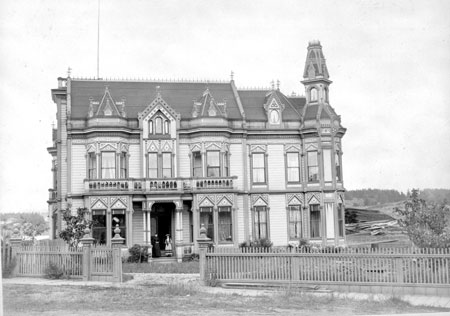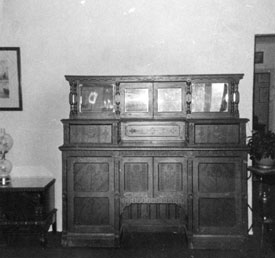Dec
10
By Ted Ross
Part Two
 |
| Image B-01502 courtesy of Royal BC Museum and Archives |
When we left our story last month, Jacob Sehl had become a successful furniture builder and choral musician in Victoria. The tale continues this month with the move to Sehl's Point (Laurel Point).
By the time of Jacob and Elizabeth's move to the new factory and mansion at Laurel Point, the children were grown and on their own. Jacob and Elizabeth missed having family around. One son, William, worked with his father in the furniture business.After Jacob's niece Maria was engaged to Leonard Maas, the couple were married in 1891 in the palatial Laurel Point residence. The newlyweds took up residence with their aunt and uncle in the spacious dwelling. They were there for three years with their daughter being born in 1893.
 |
| Image E-02364 courtesy of Royal BC Museum and Archives |
After the boom years, things took a disastrous turn in January of 1894. Since the New Year, Jacob had been bedridden with a cold. On the fifteenth of January, he finally arose from his bed on the top floor, below the cupola. Spending the day at ease, compared to his pre-illness activity, he was back to bed early.
Leonard Maas went to the basement to fix the wood-fired central heating for the night. The young man then climbed the stairs three floors to his uncle's room to socialize before heading to his bed. While chatting with Jacob, Leonard noticed a wisp of smoke come from the heat register. They checked downstairs; the house was filling with smoke.
The men roused the rest of the house. Elizabeth, Maria Maas with the nine-month old daughter, as well as Jacob and Leonard, escaped through clouds of choking smoke in what they were wearing, Jacob in his slippers, to the comparative safety of the brick factory. Fire crews, factory workers, Jacob and Leonard, in borrowed rubber boots, fought the house blaze but a hurricane-force west wind fanned the flames, blowing fly ash as far as Yates Street. All of Victoria could see the blaze.
Despite the extraordinary efforts of the fire fighters, using wooden heat shields, the house collapsed and was lost. Now the crew turned to save the factory, especially its wooden outbuildings. The wind, luckily, was blowing flames away from the factory, but the intense heat threatened those structures in any case. The crew kept them soaked as the house burned. They shifted lumber piles to safety. Everything was saved, but the house. It was a total loss.
The family moved to Driard House, an establishment furnished with Sehl products. Elizabeth never got over the loss of the house and was dead within six months, at age forty-seven, fifteen years younger than Jacob.
Jacob carried on, but things continued to turn against him. Victoria, in the late 1890s was economically depressed, and people weren't buying furniture. He was forced to close his factory and let the staff go. Operating out of his Government Street location, he tried partners, but nothing worked out. He continued to work on his own, with help from son William.
One day in the spring of 1904, while toiling in his store, he complained of the heat and sat down to rest. A short time later, at age seventy-one, he was found dead.
Returning to the Colonist of June 16, 1904, we read: "Some ten years ago the streak of bad luck which seems to pursue most men in their career, overtook Mr. Sehl. The fine residence was destroyed by fire one evening; the morning light disclosing only a heap of blackened wood where once stood a pleasant home. Fast on the heels of this disaster came business reverses. A period of hard times obtained in Victoria: the factory could not be profitably operated and was closed. In an attempt to improve his waning fortunes, Mr. Sehl made several partnership ventures in the city premises. These proved unsatisfactory and were dissolved. He married Elizabeth Van Allman, who died about nine years ago. Mr. Sehl continuing alone."
"He was one of the founders of the Pioneer Society. Of a musical turn, he organized the first German Liederkranz in Victoria, and served in the Roman Catholic Cathedral Choir."
And here ends the story of Jacob Sehl and his furniture factory, the first industrial resident of Laurel Point, and source of a great deal of music in Victoria.

Bibliography
"Germania Sing Verein," First Victoria Directory 2nd Issue, 1868; "Germania Sing Verein; Regular Monthly Soiree," British Colonist, February 13, 1869; "Thirty Thousand Dollar Loss by the Complete Destruction of Jacob Sehl's Palatial Residence: Narrow Escape of Family - Tremendous Effort Saves the Factory Adjoining," Victoria Daily Colonist, January 16, 1894; "Sudden Death of Jacob Sehl," Victoria Daily Colonist, June 16, 1904; "A Pioneer of This City Passes Away," Victoria Times, June 16, 1904; "Noted Houses of Early Day Victoria," Victoria Times, January 8, 1945; "Old Homes and Families," by J.K. Nesbitt, Daily Colonist, September 25, 1949; "Victoria's Victoria," UVIC History Department, 2002; "Chronological City History," Victoria Heritage Foundation, 2007; "History - Inn at Laurel Point," 2008; "Victoria's Laurel Point has a colourful, and fiery, past (part 1)," Cowichan Valley Citizen, February 1, 2013; "Victoria's Laurel Point has a colourful, fiery, past (conclusion)", Cowichan Valley Citizen, February 6, 2013; "Then and Now - Pendray Family - the Story," James Bay Beacon, September, 2014.
